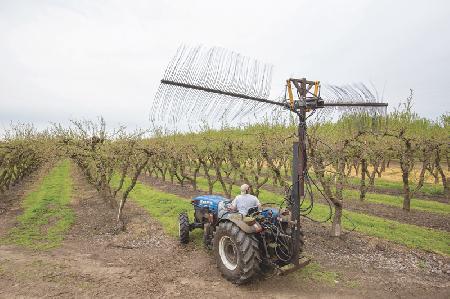String Thinner Adapted For Older-Style Peach Trees

Canning peach producer Frank Bavaro gets more peaches at less cost with his modified Darwin String Thinner. While the Darwin works great for thinning blossoms on trellised and hedged peach trees, it doesn't work on more traditional tree shapes. Now Bavaro and others with traditional orchards can also benefit from blossom thinning.
"I've used it for 2 seasons, and I?m gaining a minimum of 1 1/2 tons per acre," says Bavaro.
The Darwin String Thinner has a 10-ft. rotating spindle with 2-ft. long strings spaced every inch along the spindle. Bavaro used the original hydraulic motors and orbital spinning shafts to develop 2 thinners. For top thinning, he mounted the thinning shaft horizontally on a high post. This allows it to break up blossoms on the tops of trees. The second unit has a shaft mounted vertically on a pivoting arm. This arm is manually controlled by a worker walking behind the machine. He can move it in and out to match the shape of the trees.
"I am working on a redesign with a platform where the operator of the vertical arm can sit,? says Bavaro. "That eliminates the potential of tripping while walking and looking up."
He is also adding a second arm to the platform to thin blossoms on the accompanying row. This will eliminate a trip down the same row center.
"We'll be able to do the sides of 2 rows at a time," says Bavaro.
Bavaro uses the thinner at blossom time to reduce the load on the tree by about 50 percent. With hand labor, thinning takes place in May when pits harden. This year, he noted that fruit from trees thinned at blossom was 3 to 4 mm larger than trees that had not been thinned.
"With fewer blossoms, the tree could put its energy into those that remain," says Bavaro.
Labor costs were reduced by two thirds. In the past, it would take 25 to 30 workers to thin the trees in May. With the string thinner, he cut back to between 8 and 10 workers. Comparison trials he ran in 2015 revealed a cost per acre of $140 with the string thinner alone, while conventional hand thinning done with workers on ladders ran $810 per acre.
"Some folks had difficulty finding labor and getting their thinning done in time," says Bavaro.
The mechanically-thinned trees out-produced the hand-thinned ones significantly that year. The blossom-thinned trees produced 33.6 tons per acre for canning and 7.3 tons for juice. The trees with fruit thinned in May produced only 29.3 tons per acre of canning fruit with no fruit for juice.
"The modifications cost about $1,000," says Bavaro.
Bavaro has no intention of patenting his modifications. He hopes that other growers of both canning and fresh peaches will adapt the idea.
